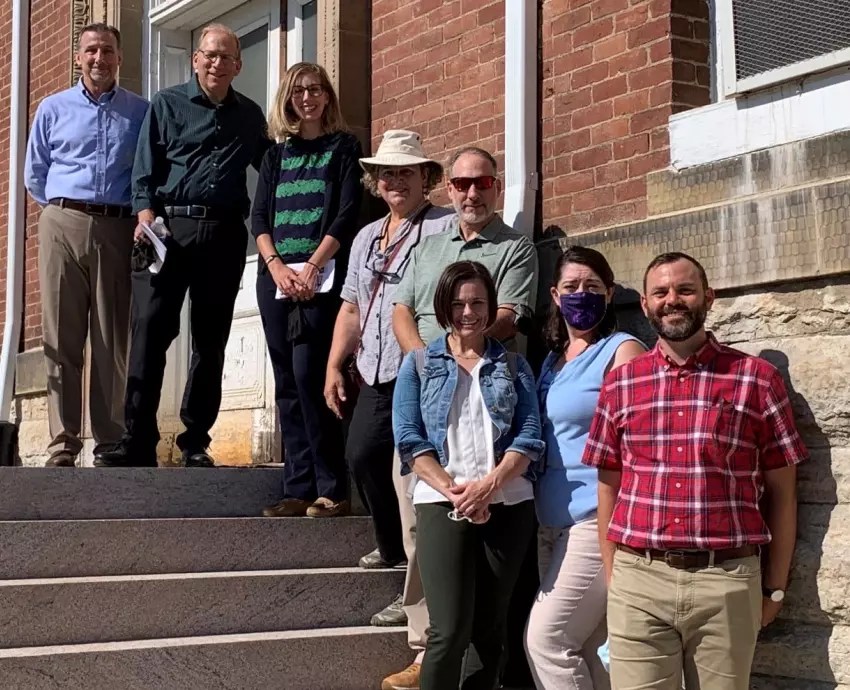
A key first step in developing a new museum is an Interpretive Master Plan (IMP) and a project team to create it. On June 9, 2021, a group of VA employees (historians representing each VA administration and others from the VA History Office team) met with the staff from the Smithsonian Exhibits program. The discussion involved the development of an IMP for the National VA History Center (NVAHC) under development on Dayton VA Medical Center campus. A Core Project Team (CPT) formed following that meeting, and they are now tasked with developing the IMP for the NVAHC. The IMP will establish how the NVAHC will serve the public and what role it will play in telling the VA story.
In August of 2021, the newly formed CPT met in Dayton, Ohio. That meeting provided an opportunity for the team members to get to know one another and establish effective working relationships that define an effective team. The Team toured the Dayton campus, including the two historic buildings that will comprise the core of the NVAHC. Building 116 (Old Headquarters) will serve as the museum and Building 129, the Clubhouse, will serve as the archival and collections center. The team developed a draft mission statement to guide the IMP development: tell the story of how the VA serves those who have served throughout the Nation’s history. They also worked on initial themes that define the exhibit sections and components.
“Gathering as a team on the future site of the National VA History Center at the Dayton VA Medical Center campus provided the grounding needed to start our work,” said Katie Delacenserie, Veterans Health Administration Historian. “The historic campus puts our purpose front and center and provided the focus needed in beginning to think about how we are going to tell the history of the VA.”
In December 2021 the Team reconvened in Dayton to further refine themes, define the functions the museum would provide, and continue strategic planning. Those brainstorming sessions resulted in lists of potential themes that each member will use to develop exhibit elements.
“The second meeting of the full VA History Team in Dayton built on the great progress made in our first meeting,” according to Historian Richard Hulver, a National Cemetery Administration Historian. “Together, the group mapped out the large themes that each Administration will want to tell and thought about overall cohesion of our story. We also spent time looking at the blank canvas that will be our museum and going out into the Dayton community to see how other historic buildings have been readapted for modern use.”
The CPT meets virtually on a weekly basis. It continues making significant progress outlining the themes and takeaway messages for the exhibits to be featured in the NVAHC. This is an important step to the development of the first VA museum. The museum is tentatively scheduled to open in 2026. Many other key milestones are still to come – from the IMP to opening the museum. We will keep you updated as we hit each milestone and this vision becomes a reality.
VA History Team – VA History Office
- Michael Visconage, Chief Historian
- Kurt Senn, Curator
- Robyn Rodgers, Senior Archivist.
- Sara Amy Leach, NCA Senior Historian
- Jeffrey Seiken, VBA Historian
- Katie Delacenserie, VHA Historian
- Richard Hulver, NCA Historian
By Kurt Senn
Curator, National VA History Center
Share this story
Related Stories
Curator Corner
It isn’t often that researchers who work with historic objects get to know the people who used those objects every day. Sometimes we get lucky and can link artifacts to certain facilities or buildings on a historic VA campus, but usually we must look for more hidden lines of evidence to figure out how an object fits into the history of those who care for our Nation’s Veterans. As nice as it would be, it isn’t as if many artifacts turn up labeled with their owners’ names! So, imagine my surprise when my teammates and I began sweeping Putnam Library for any historic objects left behind before the building is closed for renovation, and found just that.
As far as artifacts go, its story seemed simple: book presses like these would have been used to help maintain and repair the thousands of books read in Putnam Library ever since it first opened in 1879. The day that I first got up close and personal with the press, I noticed a woman’s name scraped into the black paint of the platen (the technical name for the big metal plate used to hold books together). It said “Helen Carson” in big, legible letters. As we carefully transported the heavy press down the many stairs inside Putnam Library, I looked at the name and thought “Hm…wonder who that is?”.
Curator Corner
Mary Lowell Putnam is tied to VA history by her generous donation of a large volume of books to the Central Branch of the National Home for Disabled Volunteer Soldiers. These books, meant to honor her son who died in the Civil War, helped foster reading advancement for the Veterans who lived there after the war and into the 20th Century. However, her life was more than just a moment in time donating books. It included a life-long study of languages and a very sharp opinion that she shared in writing throughout her life.
Curator Corner
Presidents George Washington and Abraham Lincoln are among the most easily recognizable figures in American history. Their faces are symbols of wisdom, strength, and leadership. Even today, polls consistently rank them as the greatest or most successful presidents. With that in mind, it is unsurprising that the appreciation of these legendary statesmen has deep historic roots. In honor of their birthdays, our team at the National VA History Center explored those roots through this pair of plaster busts.







